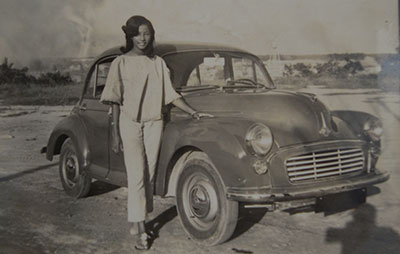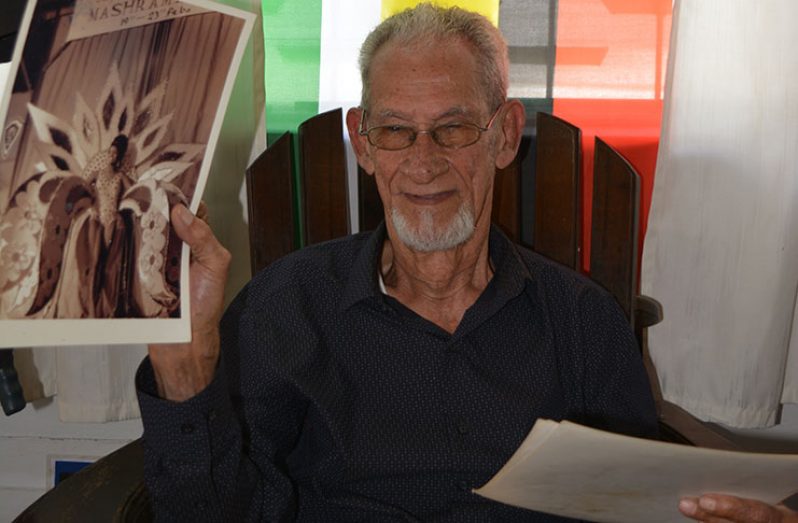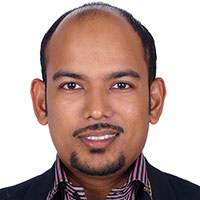– Says the event should never be called “Mash” which has no meaning
Mashramani should be a celebration of Guyanese heritage and adoption of all foreign concepts should be removed from the celebration and it should not be called “Mash”, former Public Relations Officer (PRO) and Chairman of the Jaycees of Greater Mackenzie and

founding father of the Mashramani event Jimmy Hamilton said.
Jaycees was an organisation with a mandate to promote community development in Mackenzie, Linden.
In an interview with this publication, the 86 year-old Hamilton remained a slim, distinguished-looking man who aged gracefully over the years as he gestured with his cigarette explaining the event which commemorates the country’s Republic Anniversary, which was achieved in 1970.
This year the festival will be celebrated under the theme, “Celebrate with Dignity, Liberty and Greater Unity.”
Mashramani began in the town that known as Linden in Region 10 following independence in 1966, a place where Hamilton spent 40 years of his life. The Jaycees of Greater Mackenzie which included wards of Wismar and Christiansburg was formed in 1965 by an enthusiastic group of ambitious young men from the bauxite-rich township on the Upper Demerara River who wanted to utilize their time to better themselves and their respective communities.

Consequently, numerous fundraising activities were hosted, with the main attraction being the crowning of an Independence Queen, an event whereby the various departments of the then Demerara Bauxite Company (DEMBA) would sponsor one of its female employees. The employee would then solicit support from the community members, who, by their votes, would decide the winner. Among supporters were businessmen, electricians, machinists, foremen, insurance agents, engineers, accountants and senior managers of DEMBA Limited.
As the event grew in popularity, Hamilton said the organisers decided to move it from an ‘Independence Queen’, to an ‘Independence Carnival’, which saw new features and participants.
The first such event was held in 1968, and was hailed a success. Jimmy Hamilton, who was the PRO for a number of years and later chairman, said the first ‘Independence Carnival’ queen crowned was Evadne Grasvesande. She was a student from Silver City, Wismar. The group of contestants soon grew from the four that initially participated. “In 1969 a girl from Bartica who, but I can’t recall her name.” Following the success of the Independence Carnivals, the Jaycees were faced with the task of ‘Guyanizing’ the event, as the new socialist republic would not recognise the monarchy system.
“Jour Ouvert became fo-daymawnin jump-up(a way of describing the early morning celebrations in the streets). Ole Mas became the Revolt Dance and the Calypso Contests became the Shanto Contest.” Jimmy Hamilton said as he chained smoked. He has been smoking for over six decades.
The Calypso contest was abolished and replaced by a Shanto contest. Shanto, he said is a rhythm and beat developed from a combination of African drums, East Indian strings, and Amerindian chants.
Within a short time, the group managed to win the respect and cooperation of their communities by organizing small projects, such as donating dustbins to the local authority, sponsoring scholarships to the then Mon Repos Agricultural School, painting the Mackenzie All-age School and organizing business administration courses for small businessmen, and several seminars and leadership development courses for both Jaycees and other service organisations.
Guyana was also gearing for Republican status, and in 1970, a decision was taken not to have an independence carnival in Mackenzie. Hamilton recalled that the then government had set out on a socialist agenda, resulting in a restructuring of many of the country’s traditional events.
Terms such as ‘monarchy’, ‘crowning of queen’ and ‘carnival’ had to be replaced, and the search began for patriotic names.
Former West Indies cricketer, Basil Butcher, one of the organising members, was tasked with travelling to the three Counties (Berbice, Demerara and Essequibo), soliciting interests, while Hamilton and several others were required to come up with a new name for the national celebrations.
Hamilton said the search for a name was extensive and tiresome, as it entailed research from the University of Guyana, the National Archives and several other intellectual sources, which, unfortunately, proved futile.
It was at a meeting in early December 1968 that someone suggested they find an Amerindian name.
There were over 400 Amerindians working with the bauxite company and others in settlements in Wismar, Old England, Coomaka and many others up the Demerara River.
Alan Fiedtkou, an Amerindian who worked in the geological department of the bauxite company and lived in the hinterlands was called in on the research project.
Alan had a grandfather who was over 80 years old and lived at Malali, a settlement about thirty miles by river from Mackenzie. After consulting with the old man, Fiedtkow said his granddad recalled celebrations where people living hundreds of miles apart would get together and celebrate for days in an identified area. The word used for this celebration was Arawak in origin, but in English sounded like ‘Mash-ra-mani’. It was a celebration which usually goes for days during a wedding, or after the end of hard labour.
After hearing the story, Hamilton said the organisers felt that it was the perfect patriotic name for the celebration.
The idea was immediately taken to Adrian Thompson, a historian and a District Commissioner who worked in the hinterland among several Amerindians; and following days of extensive verification, Thompson advised that the event should carry the name, “Mashramani”.
Adrian Thomson concluded that since no one could have confirmed or denied that the Arawak word for festival was Mashramani, then the festival could be called Mashramani.
Hamilton said Mashramani quickly became popular, and the celebration attracted the sponsorship of the Demerara Distillers Limited (DDL).
From Linden to Georgetown
With the first Republic Anniversary celebration fast approaching, organisers of the Independence Carnival were prompted to transform the event into a national celebration involving participation from across the country.
From every nook and cranny they came. From down river they paddled their canoes, some came on horseback, others walked long distances and yet more came by bus. The year was 1970. And the stage was well set in the bauxite town of Mackenzie.
The first Mashramani was a resounding success. Six contestants participated in the first ever Miss Mashramani contest, and 20-year-old Hazel Figueira, a Mackenzie beauty sponsored by D’Aguiar Bros, came out on top, becoming the first Mashramani Queen.
Her costume was designed by Godfrey Chin and entitled, ‘Woman and Beauty’. It depicted the ever changing mood of a woman in a riot of shimmering colours — silver, red, yellow, gold, blue and orange. Young Guitar Levans, son of the legendary Shanto singer, Guitar Levans, became the first Shanto champion in Guyana.
The costumed bands performed on stage to be judged. Large bands performed in sections, according to their themes, and the largest crowd ever to assemble in the mining town took to the streets, led by the first Miss Mashramani and her followers in an open float.
Due to logistic reasons, however, only the parade came to Georgetown, as it was hard to transport costumes and bands to the city.
President Forbes Burnham later acknowledged that Mashramani was a tremendous success.
Burnham wrote: “I congratulate the community of Mackenzie, Wismar and Christianburg not only for having presented one of the most comprehensive programmes for the first anniversary celebrations but also for having provided the title for the celebrations – MASHRAMANI.”
He contended that the name “Mashramani” was particularly appropriate since it was one of the words used by Guyana’s indigenous people – the Amerindians – in reference to the celebrations which follow a successful completion of a community or co-operative project or enterprise.
Some four decades later many celebrate Mashramani but are uncertain of its origin or of the circumstances that are responsible for the observance of the Republic’s anniversary in carnival style on February 23 each year.
The Mayor of Christianburg, Wismar and Mackenzie township later known as Linden, was not left out. He opined that “the community has matured into a township.” He further stated, “I appreciate that the JAYCEES in the continued effort to improve the area has encouraged the young men and young women to play a greater role in the civic life of the area and has encouraged them to play a greater role since there is much the young people could do if given the right stimulus.”
After Guyana gained Republican status, Mashramani was taken to Georgetown for the first time in 1972, following the then government’s call for it to travel to other parts of the country in keeping with nationalistic principles.
Hamilton disclosed that the Region Ten residents were not pleased with the idea to move Mashramani out of the Region, and that same year, the Bauxite Company in Linden decided to mount a 500-strong band to visit Georgetown to showcase Region Ten, as it felt that it needed to remind the country that Mashramani was theirs.
Hamilton said Region Ten held the reputation as the first region to mount a band of that magnitude, and later influenced other groups, such as the Joint Services, to join the bandwagon.
After witnessing the massive crowds, glitter and level of competition, Mr. David Singh, a Government Official, held discussion with the Jaycees Committee about bringing the event to Georgetown, the nation’s capital. Approval was also given by the then President Forbes Burnham for Mashramani to be a National Event for the Republic celebration. Mash activities were rotated in Linden, Berbice and Georgetown but due to sponsorship, the Costume Bands contest remained in Georgetown.
In 1972, the Jaycees were advised by the then government that the celebrations would be decentralized.
Now 87 years old and a colleague of designer Don Gomes, Hamilton has never missed a Mashramani celebration since, and believes that it is a part of him.
Companies such as GT&T, Banks DIH, Digicel and Ansa McAl have over the years, joined in the sponsorship and participation in Mashramani, making it bigger and better.
With Guyana being as large as it is, people travel from miles out of town to be a part of the celebrations, with children, food and all, because they see this day as a day of celebration. The Mash Day depicts a hive of activity from Vlissingen and lrving streets all the way to the National Park, with an air of expectancy. Thousands of people summon to the streets to participate in the annual Mashramani celebrations, which has been a part of Guyanese culture for over 50 years.



.jpg)










